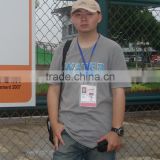Seamless air rubber PVC dam
USD $90,000 - $1,000,000 /Set
Min.Order:1 Set
Quick Details View All >
Product Details
Rubber PVC dam is made of high-strength synthetic fabrics and compound rubber, anchored in the concrete foundation to form a sealed air bladder inflated with water or air in dry seasons to store water. In rainy seasons, water or air inside of rubber bladder would be discharged to help release floodwater from river course. Compared with common civil works, the advantages of rubber dam are less engineering budget, shorter construction period, extended service life, simplified maintenance and improved vibration resistance. Rubber dam can be adjusted at any height and overflowed so it is widely used for irrigation, power generation, flood control and urban landscaping in many areas.
Physical and mechanical properties of the rubber material for making rubber bladder
Material of rubber dam:
The rubber dam tube is made of strength canvas and rubber layer which ensure tightness of the rubber layers. The rubber layers encompass outer, middle and inner elements for
different functions.
This kind of rubber is well resistant against sharp objects, pieces of ice, stone and
vibrations caused by river overflowing.
The outer layer is made of the special rubber material characterized wear, sunlight, heat and ozone-resistance.
The middle layer is used for protection of canvas and for connection of two or more canvas with rubber layers.
The inner layer is used for protection of canvas and characterized watertight and airtight features
Advantages:
1.Rubber dams can be fully deflated to pass high flows without any obstruction.
2. Can be filled air or water
2.A rubber dam can easily adapt to potential differential settlement of the foundation.
3.Rubber dam are high volume /low pressure system, so high pressure compressors are not needed
4.Simple and inexpensive operating system.
5.Rubber dam work well in cold temperature-no need to de-ice,(-15 to +80C as per different materials) no jamming of mechanical parts.
6.No lubrication of moving parts ,no painting required
7. Rubber dam don’t have leaking seals that tend to be an issue with other gate structures.
8. Easily absorbs impact shock and vibration
9. retain water
10. protect the environment
Specification Table
Item | Unit | Outer layer | Middle layer,Inner layer | Cover rubber sheet | Test standard | |
Tensile strength at break≥ | Mpa | 14 | 12 | 6 | GB/T528-2009 | |
Elongation at break≥ | % | 400 | 400 | 250 | GB/T528-2009 | |
Permanent deformation at break≤ | % | 30 | 30 | 35 | GB/T528-2009 | |
Hardness(shore A) | . | 55~65 | 50~60 | 55~65 | GB/T531.1-2008 | |
Brittleness temperature≤ | °C | -30 | -30 | -30 | GB/T1682-1994 | |
Hot air aging (100°C*96h) | Tensile strength at break≥ | Mpa | 12 | 10 | 5 | GB/T3512-2001 |
Elongation at break≥ | % | 300 | 300 | 200 | GB/T3512-2001 | |
Hot water aging (70°C*96h) | Tensile strength at break≥ | Mpa | 12 | 10 | 5 | GB/T1690-2010 |
Elongation at break≥ | % | 300 | 300 | 200 | GB/T1690-2010 | |
Volume expansion ratio≤ | % | 15 | 15 | 15 | GB/T1690-2010 | |
Ozone aging: 10000pphm, temperature 40°C, stretching 20%, no cracking | min | 120 | 120 | 100 | GB/T7762-2003 | |
Wear loss( Akron) ≤ | cm³/1.61km | 1.0 | 1.0 | 1.2 | GB/T1689-1998 | |
Flexibility, no cracking | Ten thousand times | 20 | 20 | 20 | GB/T3934-2006 | |
Contact Supplier

You May Like


New Products
Popular Searches
Recommended Products
Find Similar Products By Category